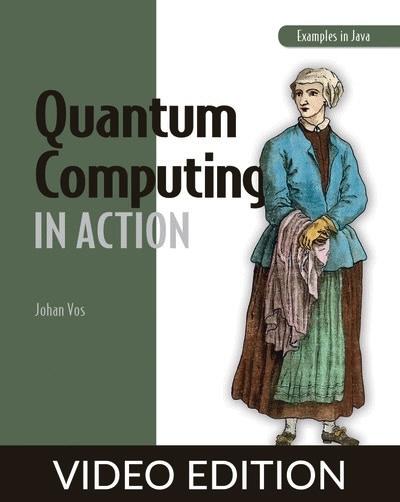English | MP4 | AVC 1280×720 | AAC 44KHz 2ch | 7h 15m | 987 MB
Quantum computing is on the horizon and you can get started today! This practical, clear-spoken guide shows you don’t need a physics degree to write your first quantum software.
In Quantum Computing in Action you will learn:
- An introduction to the core concepts of quantum computing
- Qubits and quantum gates
- Superposition, entanglement, and hybrid computing
- Quantum algorithms including Shor’s, Deutsch-jozsa, and Grover’s search
Quantum Computing in Action shows you how to leverage your existing Java skills into writing your first quantum software, so you’re ready for the quantum revolution. This book is focused on practical implementations of quantum computing algorithms—there’s no deep math or confusing theory. Using Strange, a Java-based quantum computer simulator, you’ll go hands-on with quantum computing’s core components including qubits and quantum gates.
Quantum computing promises unimaginably fast performance for tasks like encryption, scientific modeling, manufacturing logistics, financial modeling, and AI. Developers can explore quantum computing now using free simulators, and increasingly powerful true quantum systems are gradually becoming available for production use. This book gives you a head start on quantum computing by introducing core concepts, key algorithms, and the most beneficial use cases.
Quantum Computing in Action is a gentle introduction to the ideas and applications of quantum computing. After briefly reviewing the science that makes quantum tick, it guides you through practical implementations of quantum computing algorithms. You’ll write your first quantum code and explore qubits and quantum gates with the Java-based Strange quantum simulator. You’ll enjoy the interesting examples and insightful explanations as you create quantum algorithms using standard Java and your favorite IDE and build tools.
search inside this book
What’s inside
- An introduction to the core concepts of quantum computing
- Qubits and quantum gates
- Superposition, entanglement, and hybrid computing
- Quantum algorithms including Shor’s, Deutsch-jozsa, and Grover’s search
Table of Contents
1 Part 1. Quantum computing introduction
2 Evolution, revolution, or hype
3 The disruptive parts of QC Getting closer to nature
4 Hybrid computing
5 Abstracting software for quantum computers
6 From quantum to computing or from computing to quantum
7 Summary
8 Hello World, quantum computing style
9 Running a first demo with Strange
10 Inspecting the code for HelloStrange
11 Obtaining and installing the Strange code
12 Next steps
13 Summary
14 Qubits and quantum gates The basic units in quantum computing
15 Qubit notation
16 Gates Manipulating and measuring qubits
17 A first [quantum] gate Pauli-X
18 Playing with qubits in Strange
19 Visualizing quantum circuits
20 Summary
21 Part 2. Fundamental concepts and how they relate to code
22 Superposition
23 The state of a quantum system as a probability vector
24 Introducing matrix gate operations
25 The Hadamard gate The gate to superposition
26 Java code using the Hadamard gate
27 Summary
28 Entanglement
29 Independent probabilities The classic way
30 Independent probabilities The quantum way
31 The physical concept of entanglement
32 A gate representation for quantum entanglement
33 Creating a Bell state Dependent probabilities
34 Mary had a little qubit
35 Summary
36 Quantum networking The basics
37 Obstacles to quantum networking
38 Pauli-Z gate and measurement
39 Quantum teleportation
40 A quantum repeater
41 Summary
42 Part 3. Quantum algorithms and code
43 Our HelloWorld, explained
44 Abstractions at different levels
45 Other languages for quantum computing simulators
46 Strange High-level and low-level approaches
47 StrangeFX A development tool
48 Creating your own circuits with Strange
49 Simulators, cloud services, and real hardware
50 Summary
51 Secure communication using quantum computing
52 Quantum key distribution
53 Naive approach
54 Using superposition
55 BB84
56 QKD in Java
57 Summary
58 Deutsch-Jozsa algorithm
59 Properties of functions
60 Reversible quantum gates
61 Defining an oracle
62 From functions to oracles
63 Deutsch algorithm
64 Deutsch-Jozsa algorithm
65 Conclusion
66 Summary
67 Grover s search algorithm
68 Classical search problems
69 Quantum search Using Grover s search algorithm
70 Probabilities and amplitudes
71 The algorithm behind Grover s search
72 Conclusion
73 Summary
74 Shor s algorithm
75 The marketing hype
76 Classic factorization vs. quantum factorization
77 A multidisciplinary problem
78 Problem description
79 The rationale behind Shor s algorithm
80 The quantum-based implementation
81 Creating a periodic function using quantum gates
82 Calculating the periodicity
83 Implementation challenges
84 Summary
85 Getting started with Strange
86 Obtaining and installing the demo code
87 The HelloStrange program
88 Linear algebra
89 Matrix-matrix multiplication
90 Tensor product
Resolve the captcha to access the links!
